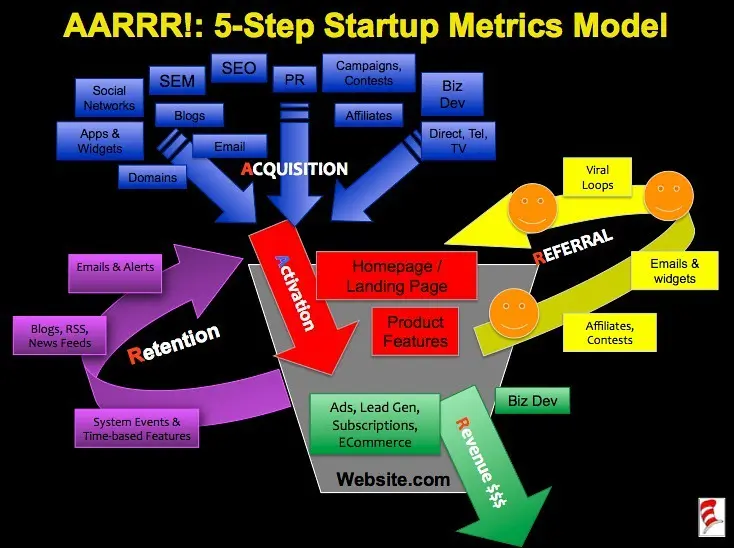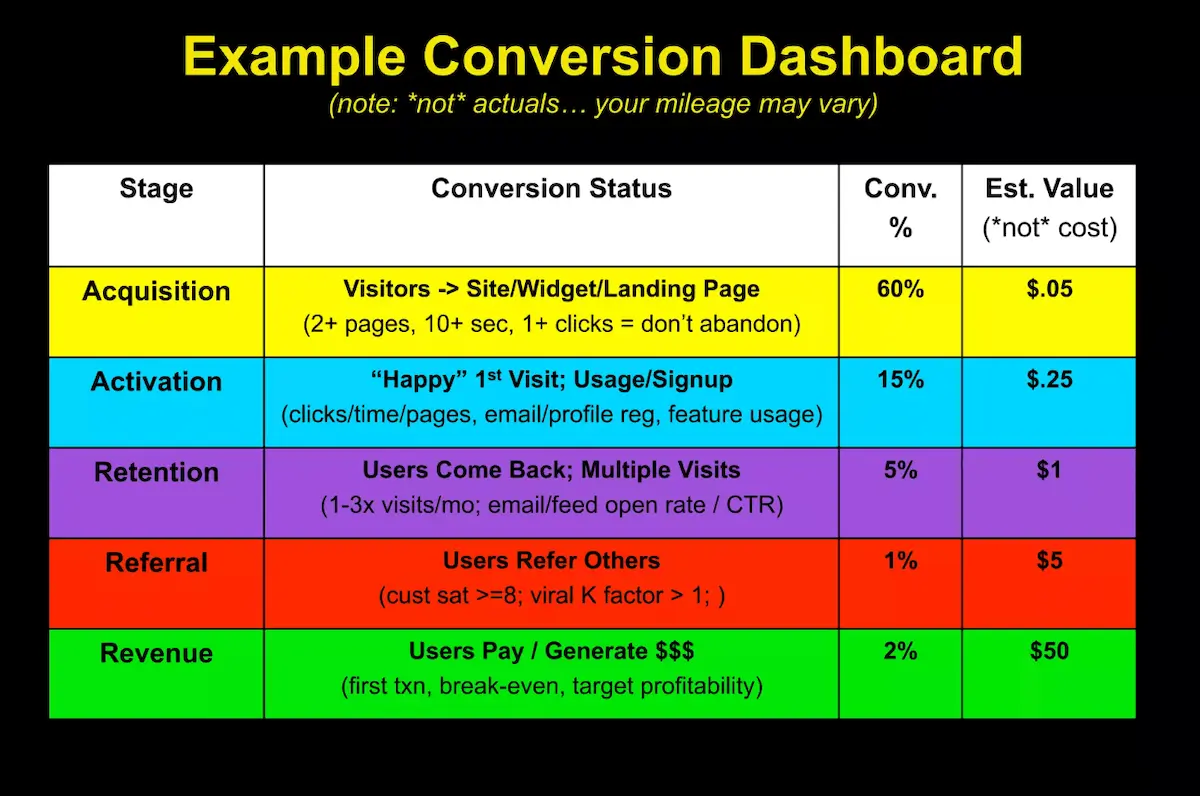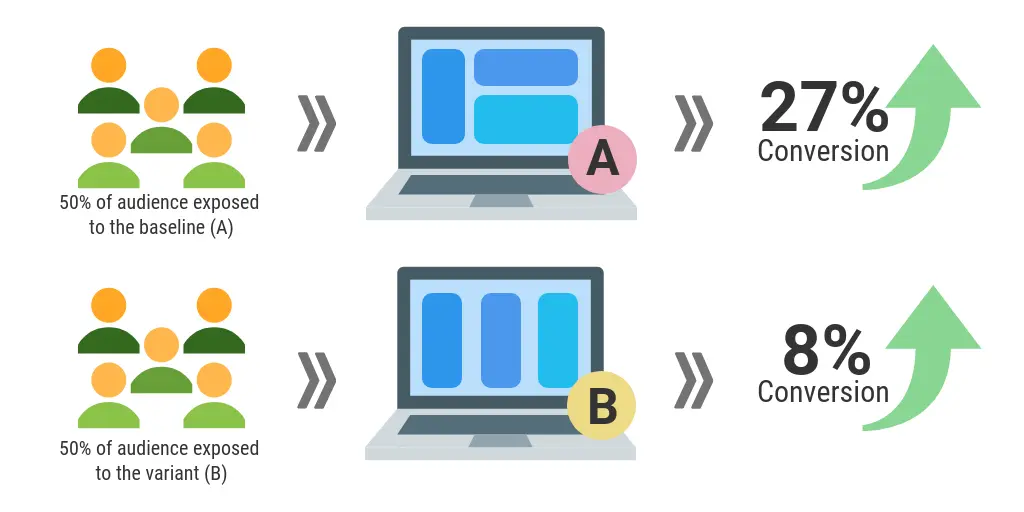Have you ever heard of the term “AARRR” and wondered what it means? If you’re interested in product management, startups, or sailing the seven seas, this is definitely something you’ll want to learn more about.
The AARRR framework or Pirates Metric Framework is a set of metrics popularly followed by startup founders, product managers, and growth marketers. The framework has little to do with pirates, except how it is pronounced (AARRR as in “Arr, matey”). Its core idea is to effectively track and influence user behavior to maneuver product-led business growth.
Dave McClure, a Silicon Valley investor and founder of 500 Startups, first coined this term in 2007. McLure realized that many founders, product managers, and marketers were increasingly diverted by superficial metrics such as social media likes that often yielded little growth results. Thus, he developed the AARRR framework to help narrow their focus and enable them to leverage the right data for startup success.
In this article, we will explore the Pirates Metric or AARRR framework in detail, and discuss ways for product managers to implement it.
Read on for answers to the following:
- What is the AARRR framework?
- How do product managers use AARRR?
- How to use the AARRR metrics: A step-by-step guide
- Bottom line: AARRR enables prioritizing data over intuition
Are you ready to get into it? Then let’s begin!
1. What is the AARRR framework?
The AARRR framework is a set of metrics meant for businesses and startups to analyze consumer behavior and scale effectively. It is used by product managers to effectively focus on metrics that matter and use only the most relevant data to derive business insights.
What does AARRR stand for?
The term “AARRR” is an acronym for Acquisition, Activation, Retention, Referral, and Revenue. These five unique categories make a robust customer-focused performance measurement framework. As per Dave’s representation of them, let’s see what each of them entails:
- Acquisition: Which channels do users come in from?
- Activation: What proportion of users have a “positive” initial experience?
- Retention: How often do visitors return as repeat visitors?
- Referral: Are they likely to tell their friends and oblige with referrals?
- Revenue: Is there any scope to monetize this behavior?
While this framework outlines the categories we just described, the actual metrics that different businesses track can for them vary. For example, you may track acquisition metrics across paid search, organic search, word of mouth, or social media.
Similarly, you may measure retention as a proportion of repeat visits to your website or the use of your product, as a response to marketing emails, or as purchases of your product or service.
Please note that these examples are not exhaustive and only define some possible metrics to track for the respective categories.
Why should you track AARRR?
The idea behind tracking and measuring information on these categories is to ascertain which parts of the customer lifecycle are performing well and identify actionable areas for improvement to grow sustainably.

2. How do product managers use AARRR?
The job role of a modern-day product manager requires navigating unpredictable situations and making critical decisions all the time. After all, it’s challenging to ensure proper alignment of the business’s aims with the end users’ needs regularly.
Getting this balancing act right requires making decisions on sound wisdom from time to time, and tracking progress is key.
Thanks to the unparalleled ability to collect data in the digital world, collecting accurate data is quite straightforward today. However, translating that data into meaningful insights is not that simple.
Firstly, it’s a function of choosing the right metrics. Next, developing a robust mechanism to track and interpret those effectively. That’s precisely how and why modern product managers depend on the AARRR framework to navigate a successful product roadmap.
3. How to use the AARRR metrics: A step-by-step guide
Wondering how to use the AARRR metrics to enhance business revenue and growth for your product? Here’s a step-by-step rundown of how to acquire and retain high-value customers to fuel growth for a product-led business.
Step 1: Identify your metrics
Using the AARRR framework in product management begins with identifying the proper conversion metrics to track user behavior across—Acquisition, Activation, Retention, Referral, and Revenue for your specific business needs.

Let’s go over some of the possible metrics for each of these.
Acquisition Stage
Here, you need to identify those metrics that determine how effectively you’re able to acquire users or customers.
For instance, if your product is an application or website, you could track the number of downloads or website visits as a measure of interest in the product. Some metrics to measure acquisition can include:
- Search engine optimization
- Social media
- Advertising
- Marketing
Activation Stage
Once prospects are exposed to your product, the next step is to get users to display interest and take desired next steps.
For instance, if your product is a website or an application, a sign of activation may be clicking on a call-to-action (CTA) button. Thus, metrics to measure activation can include:
- Page visits
- Number of users experimenting with the product’s features
- Typical dwell time on your website or app
- Number of clicks on your CTA
Retention Stage
This is the stage where users move from being curious about your product to either losing interest or sustaining it. You must work hard to retain them and ensure continued interest in your product. For those interested, the goal should be to nurture them further.
Some useful retention metrics to track retention progress can include:
- Product return rate
- Refund request rate
- Number of website revisits
- Number of repeat purchases
Referral Stage
Following retention, next, you need to closely follow your loyal customers and try to motivate them to spread the good word. After all, positive social proof is core to product success.
It’s been seen that implementing an effective reward system is an excellent way to generate social proof and get loyal customers to refer your product.
Some key metrics to track the progress of referrals can include:
- Number of signups/purchases using the referral code
- Number of clicks on the “Refer a Friend” button
- Success of referral contests
- Clicks on referral promotions in emails
Revenue Stage
The previous four stages of the customer journey we just discussed directly propel revenue growth. However, as product managers, it’s also vital to know how exactly is your revenue is generated and what each user or Customer’s Lifetime Value (CLTV) is.
Studies show more than 70% of revenue is often generated from high-value customers, and repeat customers spend 30% more than other customers.
As it costs to acquire and nurture customers, it is important to identify your high-value customers and ensure they are given the attention they need. This directly translates to more sales and revenue. Thus, this step is to calculate the “revenue per user” metric and implement a reward system that adequately reinforces their positive behavior toward the product.
Some key metrics to measure that can include:
- Minimum and break-even revenue
- Revenue compared against customer acquisition cost
As you start tracking the above metrics for the different stages, you’ll realize that other opportunities often appear organically. This is the beauty and value of using frameworks like the AARRR.
Step 2: Shortlist tools to track and analyze AARRR metrics
After identifying your list of relevant metrics, you need to pick the best-suited tools and methods to collect and analyze the data you plan to track.
Some useful tools for tracking identified metrics for each of the AARRR stages include:
Acquisition Stage
- Google Analytics to understand website behavior
- KISSmetrics to understand customer’s journey across devices
- Ahrefs for keyword research, competitor analysis, and SEO
- UberSuggest for generating content ideas
- BuzzSumo for identifying content that performs well
Activation Stage
- Hotjar Session Recordings to replay web sessions
- FullStory to discover genuine customer frustrations
- Crazy Egg to understand user behavior in detail
- Hotjar Heatmaps for identifying where people spend more time on a webpage
- Lucky Orange to spot any UX/UI issues faced by individual users
Retention Stage
- Amplitude to ascertain what keeps customers loyal
- Qualaroo to collect accurate customer feedback
- ZenDesk to understand customer satisfaction metrics
- User Pilot for insights into customer opinions
- Tidio to improve customer service using live chat and chatbots
Referral Stage
- Referral Factory for access to 1000+ pre-built referral programs
- Refersion to get influencers to spread the word about your product
- CrewFire to turn your customers into brand ambassadors
- FriendBuy to implement loyalty-based referral programs
- InviteReferrals to make it easy for customers to refer to their network
Revenue Stage
- Dreamdata to gather insights related to the sales pipeline
- Revenueanalytics.com for pricing strategies
- Insightsquared.com to derive intelligent insights about your revenue-related trends
- Boostup.ai to generate insights concerning revenue
- Klearly.com to enhance demand generation outcomes
As a practice, it’s a good idea to assign an estimated budget for each user behavior category. Doing so helps to clarify where your efforts yield good ROI and where you can improve.
Step 3: Run A/B tests
With the previous steps, you unlock a pool of objective data for your analysis. According to McClure, you should then run A/B tests to improve user engagement across the stages of the AARRR framework.
An A/B test compares the performance of two versions. It identifies which appeals more to users, thereby helping you optimize results in product management.

For example, let us suppose that your acquisition metrics show satisfactory results. However, you observe that you could improve retention rates. In this situation, you may run variations of A/B tests for retention to figure out how to fix this, keeping acquisition strategies and tactics unchanged.
Some practical tools you can use for conducting A/B testing include:
- VWO to help with making data-driven decisions
- AB Tasty to experiment, personalize, and optimize your products
- Convert to enhance your conversion rates
- Freshworks to implement a variety of A/B tests
- Optimizely to improve your existing content, visuals, web performance, etc.
Step 4: Use insights to guide decisions and forecasts
Finally, once you know what’s working at each level of the AARRR framework, you need to translate all that information into practical and effective actions. Making business decisions based on insights over pure intuition is always advisable to achieve the best results.
By using the AARRR framework, you can put together a simple and verifiable plan of action to improve your products and ultimately enhance customer satisfaction metrics.
4. Bottom line: AARRR enables prioritizing data over intuition
Dave McClure’s AARRR framework is an excellent way for startups and businesses to drive product-led business growth. It equips product managers and growth hackers with the ability to identify vital metrics to measure performance and generate crucial insights for business growth.
As product managers, using the AARRR framework provides excellent direction to understand customers, refine the funnel and navigate effective revenue and growth strategies.
The steps start with shortlisting the metrics that matter and ways to track them accurately. Thereafter, run A/B tests to optimize outcomes and use analysis results to guide effective decision-making. We hope that with the tools we’ve listed for each of the stages, you’ll be able to glide into effective application of the AARRR framework.
If you found this topic interesting and want to learn more about navigating a successful product management career, sign up for this free Product Management for Beginners course
Here are some additional resources to explore:
